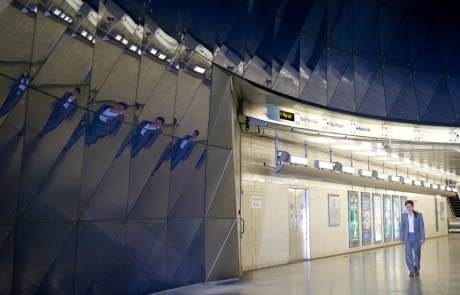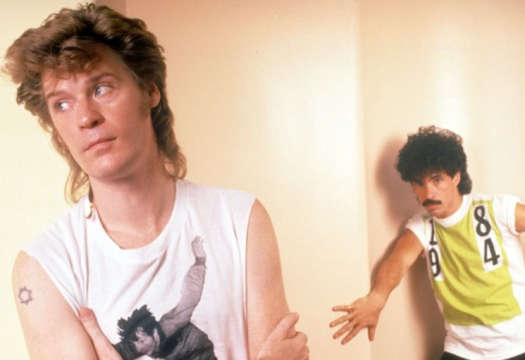Danny Boyle, a director that vacillates between the gritty underworld of unembellished violence and the mainstream world of uplifting pap, has one auteur consistency throughout his library of works: a propensity for style over substance.
Whether shooting his films with multiple grains and washed-out palettes or forcing a kinetic propulsion through oblique stylizations and an aggressive, omnipresent soundtrack, there's always a focus on visual trickery and gimmickry to preoccupy the senses. Fish-eye views, rapid-paced montages and semi-orgasmic, increasingly rapid, shot/reverse shot edits and a techno-pop "fusion" soundtrack are just some of the characteristics the British director is known for.
With Trance, he's exaggerated his aestheticism with a gritty, grainy, washed-out look made anarchic by a desultory shot composition that's either zooming, panning or sitting slightly off-centre, focusing on characters and actions from unconventional angles while the rhythmic, pulsating booms of Rick Smith's electronic score inject a perpetual rush of adrenaline.
The deliberate (but woefully facile) mind-fuck of a plot is perfect for his visual experimentation, similarly embracing his need for hipster validation by jumping back in time to R-rated nastiness like Trainspotting or 28 Days Later.
Initially set-up as a heist film, a rapid succession of first-person factoids from London art auctioneer Simon (James McAvoy), detailing the precautions taken for preventing the robbery of an item up for bids, sets the stage for an Ocean's Eleven sort of play on plotting. This time, Goya's "Witches in the Air" is the object of a desire; it's a piece noted for introducing pubic hair to the mainstream art world (and, yes, this is a plot point).
But when the robbery goes wrong and Simon is left with short-term memory loss, lead thug Franck (Vincent Cassel) seeks creative ways to extract his memories, which include the location of the painting, enlisting the help of hypnotherapist Elizabeth Lamb (Rosario Dawson). Quick to tap into his unconscious, she manoeuvres around the many safeguards the criminals have in place to "help" her client while herself getting a piece of the windfall.
As usual, nothing is as it seems, with double-crosses and buried plot points re-emerging at opportune moments to provide twists aplenty. Boyle's interest in it all is framing and styling the hypnotic "trances" experienced by Simon, blending elements of reality and dream into a shallow breakdown of a duplicitous character going through emotional turmoil, of an Eternal Sunshine of the Spotless Mind variety.
Through it all, there's a comment on the role of gender amidst the modern global economy, suggesting that while greed might motivate the crew of interchangeable male cronies, women are influenced by far more elaborate and calculated motivators. As such, there's a discomforting degree of misogyny at play — the men ostensibly view women as similarly valuable proprietary objects like the painting — making the graphic, full-frontal nudity and use of Rosario Dawson's pubic hair (or lack thereof) as a metaphor for the controlled simplicity of the male mind bizarre and almost contrarian.
Still, Trance is the sort of work that delivers on the experiential front, packing an invigorating emotional punch when it exploits a known mixture of editing and soundtrack work to build a sequence up to its climax; it's just unfortunate that there's very little depth beyond the visual side.
Had Boyle not tenuously tried to reach for the weird, childishly handled subtext about gender, economy and the sustainment of the male ego (i.e., broken memory), this could have been an effective little puff piece. But there's something unseemly about how it all fits together.
(Searchlight Pictures)Whether shooting his films with multiple grains and washed-out palettes or forcing a kinetic propulsion through oblique stylizations and an aggressive, omnipresent soundtrack, there's always a focus on visual trickery and gimmickry to preoccupy the senses. Fish-eye views, rapid-paced montages and semi-orgasmic, increasingly rapid, shot/reverse shot edits and a techno-pop "fusion" soundtrack are just some of the characteristics the British director is known for.
With Trance, he's exaggerated his aestheticism with a gritty, grainy, washed-out look made anarchic by a desultory shot composition that's either zooming, panning or sitting slightly off-centre, focusing on characters and actions from unconventional angles while the rhythmic, pulsating booms of Rick Smith's electronic score inject a perpetual rush of adrenaline.
The deliberate (but woefully facile) mind-fuck of a plot is perfect for his visual experimentation, similarly embracing his need for hipster validation by jumping back in time to R-rated nastiness like Trainspotting or 28 Days Later.
Initially set-up as a heist film, a rapid succession of first-person factoids from London art auctioneer Simon (James McAvoy), detailing the precautions taken for preventing the robbery of an item up for bids, sets the stage for an Ocean's Eleven sort of play on plotting. This time, Goya's "Witches in the Air" is the object of a desire; it's a piece noted for introducing pubic hair to the mainstream art world (and, yes, this is a plot point).
But when the robbery goes wrong and Simon is left with short-term memory loss, lead thug Franck (Vincent Cassel) seeks creative ways to extract his memories, which include the location of the painting, enlisting the help of hypnotherapist Elizabeth Lamb (Rosario Dawson). Quick to tap into his unconscious, she manoeuvres around the many safeguards the criminals have in place to "help" her client while herself getting a piece of the windfall.
As usual, nothing is as it seems, with double-crosses and buried plot points re-emerging at opportune moments to provide twists aplenty. Boyle's interest in it all is framing and styling the hypnotic "trances" experienced by Simon, blending elements of reality and dream into a shallow breakdown of a duplicitous character going through emotional turmoil, of an Eternal Sunshine of the Spotless Mind variety.
Through it all, there's a comment on the role of gender amidst the modern global economy, suggesting that while greed might motivate the crew of interchangeable male cronies, women are influenced by far more elaborate and calculated motivators. As such, there's a discomforting degree of misogyny at play — the men ostensibly view women as similarly valuable proprietary objects like the painting — making the graphic, full-frontal nudity and use of Rosario Dawson's pubic hair (or lack thereof) as a metaphor for the controlled simplicity of the male mind bizarre and almost contrarian.
Still, Trance is the sort of work that delivers on the experiential front, packing an invigorating emotional punch when it exploits a known mixture of editing and soundtrack work to build a sequence up to its climax; it's just unfortunate that there's very little depth beyond the visual side.
Had Boyle not tenuously tried to reach for the weird, childishly handled subtext about gender, economy and the sustainment of the male ego (i.e., broken memory), this could have been an effective little puff piece. But there's something unseemly about how it all fits together.




